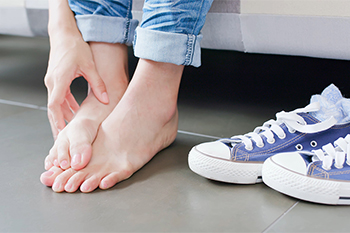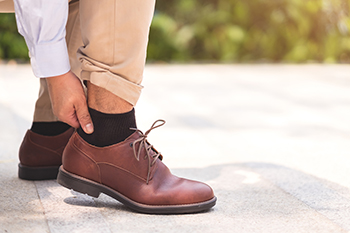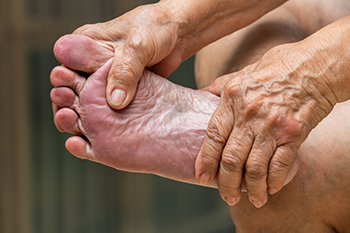
Certain afflictions of the foot that can hinder the health of your feet involve the nerves. Tarsal tunnel syndrome is one such condition. An individual can develop this affliction when the nerve that runs through the tarsal tunnel becomes compressed. The tarsal tunnel is found near the Achilles tendon, and the affected nerve is known as the tibial nerve. This nerve can become compressed in the tarsal tunnel for a variety of reasons. Most commonly, compression is due to an injury or stress over a prolonged period of time. Those who suffer from tarsal tunnel syndrome can experience a wide range of symptoms. For example, a patient might notice painful sensations that can reach well into the foot’s arch. Additionally, those with tarsal tunnel syndrome can experience a feeling of numbness, especially in the bottom of the feet, known as the soles. Swelling is also another common symptom of this foot condition. Pain caused by tarsal tunnel syndrome can sometimes make it more difficult to engage in physical activities such as walking and running. If you believe that you may have tarsal tunnel syndrome, contact a podiatrist for a diagnosis.
Tarsal tunnel syndrome can be very uncomfortable to live with. If you are experiencing tarsal tunnel syndrome, contact Alex Kim, DPM of AVID Foot & Ankle Center. Our doctor can provide the care you need to keep you pain-free and on your feet.
Tarsal Tunnel Syndrome
Tarsal tunnel syndrome, which can also be called tibial nerve dysfunction, is an uncommon condition of misfiring peripheral nerves in the foot. The tibial nerve is the peripheral nerve in the leg responsible for sensation and movement of the foot and calf muscles. In tarsal tunnel syndrome, the tibial nerve is damaged, causing problems with movement and feeling in the foot of the affected leg.
Common Cause of Tarsal Tunnel Syndrome
- Involves pressure or an injury, direct pressure on the tibial nerve for an extended period of time, sometimes caused by other body structures close by or near the knee.
- Diseases that damage nerves, including diabetes, may cause tarsal tunnel syndrome.
- At times, tarsal tunnel syndrome can appear without an obvious cause in some cases.
The Effects of Tarsal Tunnel Syndrome
- Different sensations, an afflicted person may experience pain, tingling, burning or other unusual sensations in the foot of the affected leg.
- The foot muscles, toes and ankle become weaker, and curling your toes or flexing your foot can become difficult.
- If condition worsens, infections and ulcers may develop on the foot that is experiencing the syndrome.
A physical exam of the leg can help identify the presence of tarsal tunnel syndrome. Medical tests, such as a nerve biopsy, are also used to diagnose the condition. Patients may receive physical therapy and prescriptive medication. In extreme cases, some may require surgery.
If you have any questions please feel free to contact our office located in Little Elm, TX . We offer the newest diagnostic and treatment technologies for all your foot and ankle needs.





